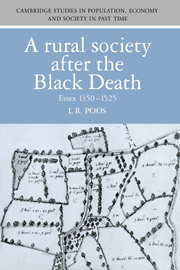Book contents
- Frontmatter
- Contents
- List of figures
- List of tables
- Preface
- Abbreviations
- Part I Reflections on a transitional era
- Part II ‘Country-dwellers, common folk and craftsmen’
- Part III ‘The total sum of all persons’
- Part IV ‘While it is so forward between us’
- Part V ‘She came that day seeking service’
- Part VI ‘Beware of such holy men’
- 11 Authority and rebellion
- 12 Religious nonconformity and parochial activism
- 13 Literacy
- Part VII Synthesis
- Bibliography
- Index
- Cambridge Studies in Population, Economy and Society in Past Time 18
12 - Religious nonconformity and parochial activism
Published online by Cambridge University Press: 14 September 2009
- Frontmatter
- Contents
- List of figures
- List of tables
- Preface
- Abbreviations
- Part I Reflections on a transitional era
- Part II ‘Country-dwellers, common folk and craftsmen’
- Part III ‘The total sum of all persons’
- Part IV ‘While it is so forward between us’
- Part V ‘She came that day seeking service’
- Part VI ‘Beware of such holy men’
- 11 Authority and rebellion
- 12 Religious nonconformity and parochial activism
- 13 Literacy
- Part VII Synthesis
- Bibliography
- Index
- Cambridge Studies in Population, Economy and Society in Past Time 18
Summary
Longstanding political volatility in the Essex countryside was matched by a persistent strain of religious nonconformity. The northern portion of the county in particular has long been recognised as a place where Lollardy, the quintessential English heresy of the later middle ages, fell upon especially fertile ground, and no survey of anti-authoritarian activity in the district can ignore it. Indeed, as already emphasised, in episodes like Oldcastle's revolt or Cade's rebellion it can be quite difficult to assign relative importance to political, social and religious factors. All sprang in part from the same roots, deeply embedded in local social structure and mentality. Religious nonconformity was an extremely complex phenomenon. Doctrinally it ranged from (at one extreme) the formal theological heresies of John Wyclif, of academics sympathetic to his views in the years surrounding his death in 1384, and of more isolated clerics and writers at a later date, to (at the other extreme) a relatively looser collection of anti-clerical and anti-sacramentarian attitudes at the humbler social levels of the laity. It is precisely this underground quality, as an often only partly articulated belief system, mostly perpetuated in small cells through written texts and by minor unbeneficed clergy or lay people, that makes it difficult to chart its dimensions and clientele for much of the period.
Post-Black Death Essex was no stranger to dissident clerics with disturbing messages. As early as 1367 the Archbishop of Canterbury was issuing warnings to the deanery of Bocking, which was under his direct or ‘peculiar’ jurisdiction, against the preaching of the notorious John Ball, ‘pretending himself to be a priest’, and later famed as a shadowy protagonist in the 1381 revolt.
- Type
- Chapter
- Information
- A Rural Society after the Black DeathEssex 1350–1525, pp. 263 - 279Publisher: Cambridge University PressPrint publication year: 1991



